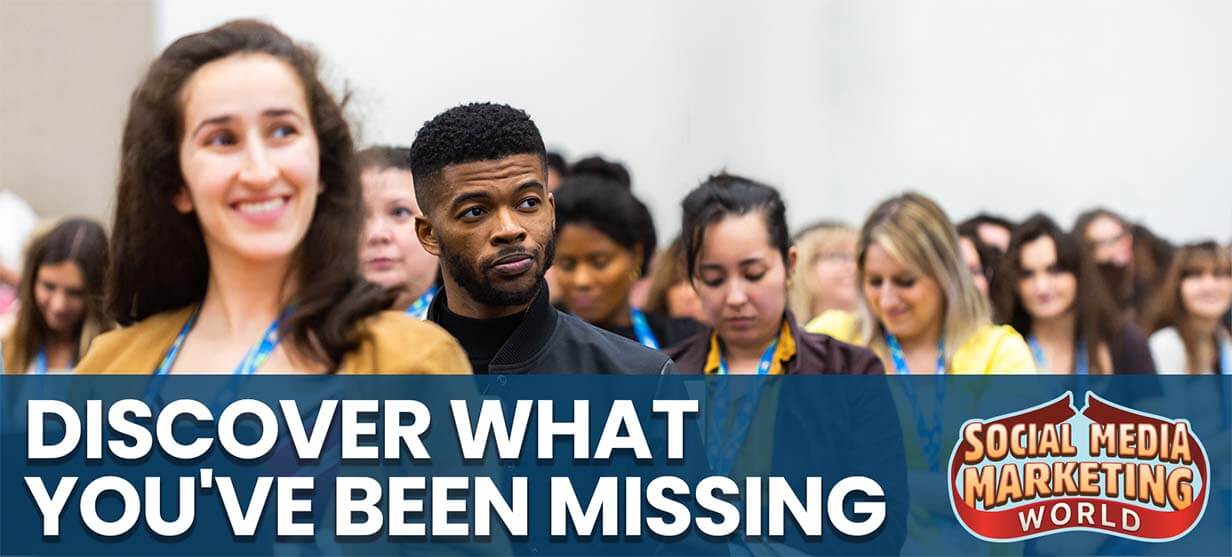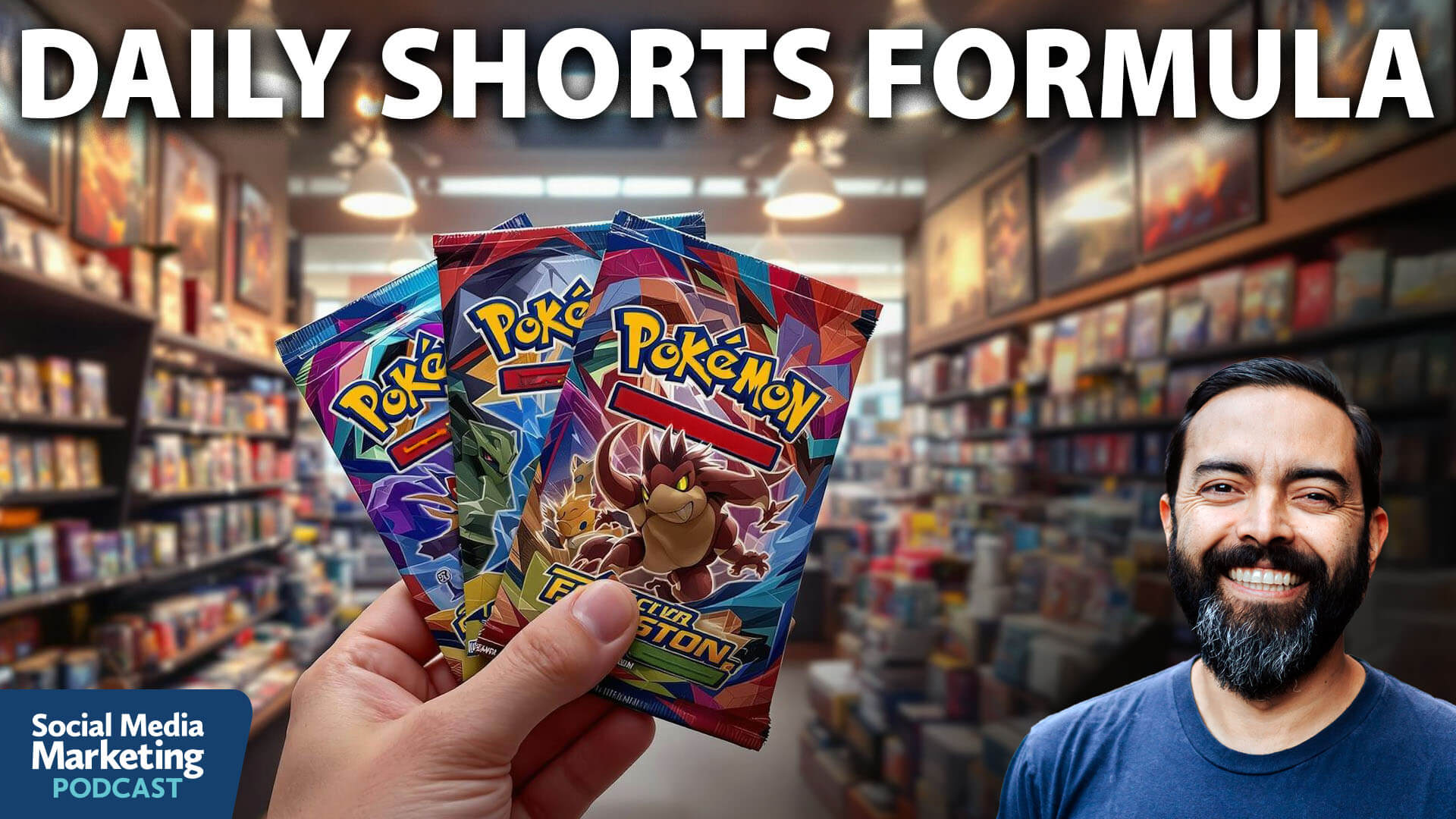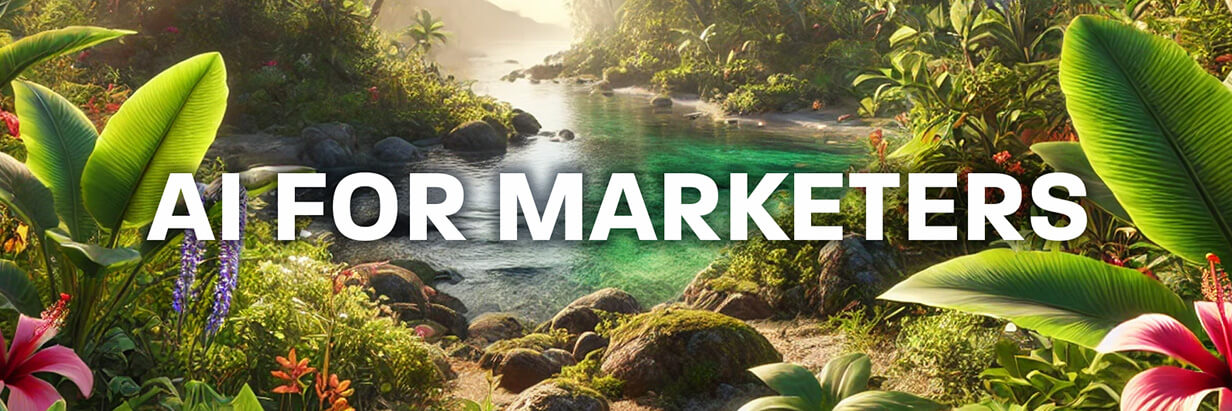Today's Guide to the Marketing Jungle from Social Media Examiner...
presented by 
The weekend is almost here, Alluser! Here's a recap of the most important insights, trends, and updates from the week. Catch up in minutes and go into next week prepared.
In today's edition:
-
Shoot better video on your smartphone
-
One-to-Many messaging on TikTok
-
Meta ad templates that don't look like ads
-
Making a short-from video series work
-
3 ways AI can drive business results
-
6 Ready-to-Use AI Prompts for Content Strategists
-
7 New ways to use Claude
-
🗞️ Industry news from Snapchat, X, YouTube and more

Transform Your Smartphone Videos into Professional-Looking Content
Ever wondered how some people create stunning videos with just their phones? Steve Wright breaks down everything from basic techniques to advanced smartphone filmmaking tricks that'll completely level up your mobile video game.
You'll learn why shooting at eye level is boring (and what angles to use instead), how to achieve buttery-smooth camera movements and the simple accessories that make a massive difference. The guide shows the stark contrast between beginner and pro footage of the exact same scenes—it's honestly mind-blowing what a difference proper technique makes!
There are tons of practical tips, such as using slow motion to add drama, capturing fake drone shots without actually needing a drone, creating a cinematic b-roll while filming solo, and adding those professional touches with color grading and sound effects. Read more here.
My Bulletin on TikTok
If you've been waiting for a public, one-to-many messaging feature that allows you to share updates with your brand's TikTok followers, Keenya Kelly has some news for you!
TikTok is going to to roll out a tool that is very similar to Instagram's broadcast channel, and she has a first look for us. Read more here.
Meta Ad Creative Templates for 2025
Looking to boost your Meta ad performance this year? Ben Bennett just shared the top 5 ad creative templates working right now.
These templates include problem-focused contextual ads, disguised product demos that don't feel salesy, practical pain points with emotional hooks, narrative-style ads with trust elements, and the surprisingly effective Amazon review format.
The breakdown is super actionable and each template comes with real examples, explanations of why they work, and clear steps to implement them yourself, even on a small budget with zero production experience. Read more here.

How to Be More Valuable in 2025…
Are you feeling undervalued at work? Are you looking for a way to shine to your boss or clients?
Imagine acquiring specialized knowledge that helps you get a raise, increase your rates, or bring in more revenue for your company. That's what happens with a Virtual Ticket to Social Media Marketing World.
"The Virtual Ticket alone has taught me more about social media and marketing than my entire college degree. Honestly, this conference is why I have the position I have now," said Holly Carlson.
I'm ready for all the recordings.

How to Create a Short-Form Video Series
Are you looking for a breakthrough content strategy? Wondering if a short-form video series could transform your marketing results?
Creating a consistent short form video series can transform your social media presence. While many marketers and content creators focus on producing random individual short videos, a strategic series approach offers significant advantages.
For example:
-
Building Subscriber Loyalty: A series creates clear expectations that encourage subscriptions. People will subscribe because they know what they'll get next.
-
Creating Viewing Rituals: Regular engagement is much harder to achieve with random content.
-
Simplified Production Workflows: Having a consistent format allows creators to develop templates, shortcuts, and processes that drastically reduce production time.
-
Narrative Continuity: A series allows you to reference previous episodes, building storylines that span multiple videos.
-
Community Building: Regular viewers begin to recognize inside jokes and recurring elements, creating a sense of belonging.
Pat Flynn's journey into short form video started as an experiment. Already successful with his long form Pokemon channel Deep Pocket Monster (1.5 million subscribers), Flynn decided to test whether he could build an audience with short videos.
He launched a separate, faceless channel called "Should I Open It or Should I Keep It Sealed?" The concept was simple: every day, he would open a pack of Pokemon cards to see if he got valuable cards or not.
Around day 21, his videos were only getting a few hundred views but Flynn stayed committed to the process.
The breakthrough came around day 32-33 when one of his videos suddenly received a million views in less than 24 hours. This success pushed his other videos up, and he began reaching tens of thousands, sometimes hundreds of thousands of views per video. By analyzing which videos performed well, Flynn identified elements to replicate in future content.
Today, Flynn's short form channel has over one billion views across platforms and has grown to over a million subscribers. It generates five-figure monthly revenue, has led to brand deals, partnerships, and even an invitation to open Pokemon cards on field at a Detroit Lions game.
Commit to a 60-Day Experiment
Committing to a 60-day timeframe creates what Pat Flynn calls voluntary force functions–a pattern of constraints that help you develop discipline and efficiency.
Rather than worrying about how the day's video is doing, the focus becomes, "Did I actually create a video today and did I learn anything from it?"
This approach removes the pressure of immediate success and allows you to focus on improvement and consistency - things you can control. Instead of setting view or subscriber goals that you can't directly influence, focus on the daily practice of creating, refining, and showing up.
60 days is a good timeframe because:
-
It's long enough to see meaningful patterns emerge
-
It creates urgency without being overwhelming
-
It gives you an end date to evaluate results objectively
-
It forces you to develop time-efficient processes
This fixed timeframe also makes it easier to get buy-in if you're proposing this experiment for a brand or team.
Develop a Simple Short-Form Video Framework
The key to a successful, sustainable series is creating a simple, repeatable format that viewers can immediately understand. Flynn recommends brainstorming many potential frameworks, then selecting one that's easy to communicate and feels right for your expertise and audience.
Here are so industry-specific framework ideas that work well:
For professional service businesses:
-
A daily "Myth vs. Reality" series where you debunk a common misconception in your industry
-
A "Before & After" series showcasing client transformations with the same format each time
-
A "Quick Win" series where you demonstrate one small actionable tip that creates immediate value
For product-based businesses:
-
A "Customer Spotlight" series with a consistent interview structure
-
An "Unknown Feature" series highlighting overlooked aspects of your product
-
A "How It's Made" series showing behind-the-scenes glimpses of your production process
For marketers serving other businesses:
-
A "High-Low Sales Pitch" where you reveal a product, hide the price, guess its value, and track your accuracy over time
-
"Born With It or Built It" profiles of successful entrepreneurs revealing if they inherited wealth or created it themselves
-
A "60-Second Strategy" series covering one focused marketing tactic per day
Once you have ideas, test them by explaining the concept to others. Flynn advises: "Go down the office and say, 'Hey, what do you think of a video series where I do X, Y, and Z?' If they respond with, 'Wait, when you say that, what do you mean?' that doesn't work yet."
Examples of other successful series are a photographer who approaches strangers with dogs and takes professional photos, or a golfer attempting to make a hole-in-one over his house with an increasing number of balls each day.
Today's advice is provided with insights from Pat Flynn, a featured guest on the Social Media Marketing Podcast.
Watch the full interview on YouTube
How AI Helps Leaders Accelerate Business Growth
Want to make smarter, faster business decisions with AI? Wondering how leaders can effectively leverage AI without getting lost in technical details?
In this article, you'll discover a practical framework for becoming an AI-driven leader who can harness artificial intelligence to enhance strategic thinking and decision-making across your organization.
Begin With Two Sticky Notes
The first step in becoming an AI-driven leader isn't to delegate AI to someone else—it's to become competent with AI yourself.
First, grab a sticky note and write, 'How can AI help me do this?' and put that note on your computer or desk. This reminder will change your perspective as you go about your work throughout the day. Instead of asking, "What can I do with AI?" you'll start asking, "How can AI help me do this?"
On a second sticky note, write: "Context, Role, Interview, Task"
Geoff Woods uses this CRIT framework for 99% of his AI prompts, and it will provide you with a structured approach to interacting with AI effectively.
-
Context: Provide background information
-
Role: Assign AI a specific role
-
Interview: Have AI ask you questions to gain more context
-
Task: Specify what you want AI to accomplish
3 Ways to Use AI to Drive Business Results
Pitch Deck Reviews
About an hour before presenting an important sales pitch deck to a large company, Woods opened ChatGPT and followed his CRIT framework.
First, he gave ChatGPT details about context and role:
Context: I'm about to give this proposal to [company name]. Here is the proposal [uploaded PDF]. I'm about to meet with the executive and their chief of staff. We have an hour allocated for this. Role: I want to be able to role play with you as them so that you can give me feedback on what I do well, what I don't do well, and the top changes I can make. Your role is to act as both people.
After describing the personalities of both the executive and chief of staff in detail, Woods continued with the interview and task instructions:
Interview: When I confirm, I'll switch to voice mode and give you the proposal. Task: When I say, "All done," I want you to challenge me, ask questions, and raise objections. I don't want you to be nice. I want you to make this a ten out of ten tough.
Woods then practiced his entire pitch with ChatGPT's advanced voice mode, which interrupted him with questions and objections. When he finished saying "all done," ChatGPT provided feedback highlighting a critical oversight—he hadn't outlined a return on investment. Woods immediately amended his deck to address this gap.
Financial Statement Analysis
When reviewing his financial statements, Woods opens ChatGPT and applies his CRIT framework:
Context: Here are our financials [drag and drop]. Role: You're a strategic CFO who's a world-class expert in telling a CEO the top five non-obvious insights about their business based on their financials that they don't know that they should know. Interview: Ask me up to five questions, one at a time, to gain deeper context. Task: Give me the top five non-obvious things about my business that I should know as a CEO.
This approach has become a monthly rhythm for Woods because it helps him see patterns and insights he might otherwise miss.
Board Presentation Reviews
When a CEO in his network was struggling with a hostile board that consumed 50% of the executive team's time, Woods helped develop a novel solution.
First, Woods pulled the executive team together on Zoom and used ChatGPT with his CRIT framework.
Context: I'm the CEO of this company. We have a hostile board. Every quarter is an absolute bloodbath, and 50% of my executive team's time is gobbled up by board shenanigans and distractions. We've been working toward an exit in the next twenty-four months, but I just got a call from the chairman saying if I don't rehab the relationship in the next six months, we're all fired. Role: Your role is to act as an HR professional with deep expertise in creating personality profiles. Interview: "Interview me. Ask me one question at a time. You get to ask as many questions as you want until you understand one of our board members, Susan, on a deep enough level so you can accomplish the task of creating a personality profile for her. Task: Create a personality profile for Susan.
Then, the AI conducted the interview, asking the executive team questions about Susan. As the executive team responded, Woods literally typed their responses word for word.
After this process, the AI created a personality profile, which the executive team reviewed critically: "They said, here's what I like about it. Here's what I don't like about it. Here are the top changes we need to make."
They repeated this process for each board director, creating personality profiles for every board member.
Then, they built a custom GPT that included these profiles with instructions:
Your job is to be our AI board. Every quarter, we'll give you our deck before the meeting. Your task is to review every slide as every director and simulate how you think they will react.
The AI quickly identified potential sections of the presentation that could derail the board meeting. In one case, it predicted that a particular board member would get distracted by details on slide eight, leading to a 30-minute detour. Then, the AI gave the team a suggestion to modify the presentation in a way that would appeal more favorably to the director.
Finally, the team implemented an AI note-taker in the meetings. They upload the transcript and tell the AI to compare its simulation to what actually happened in the meeting, then adjust the personality profiles based on the reality.
Within two board meetings, the board told the CEO, "These are the best decks we've ever had and the best meetings we've ever had. What changed?"
Today's advice provided with insights from Geoff Woods, a featured guest on the AI Explored podcast.
Watch the full interview YouTube
🚨 Heads Up, No Talk Show This Week! 🚨 We took a short break, but don't worry! The next Social Media Marketing Talk Show will be back in your inbox on April 7. Mark your calendar for the latest Facebook insights and updates. See you then!

6 AI Prompts to Supercharge Your Content Strategy
Looking to level up your content game? Andy Crestodina just dropped a super practical guide showing how AI can transform your content strategy - no fancy tech degree required!
He walks through six copy-paste prompts that help with everything from understanding your audience to finding trending topics that'll actually get engagement.
The guide covers creating audience personas (because AI = Average Information until it knows your audience), crafting email CTAs that convert, discovering social topics people actually care about (hint: opinions trigger algorithms!), generating original research ideas that attract backlinks, finding communities where your target audience hangs out, and using your GA4 data to match topics with promotion channels.
The best part? You don't need to be an AI wizard - just copy, paste, and tweak. Each prompt is ready to use in any LLM (ChatGPT, Claude, Gemini, whatever you prefer). Read more here.
7 Game-Changing Uses for Claude 3.7 Sonnet
Everyone's talking about Claude 3.7 Sonnet's coding abilities, but that's just scratching the surface. Rick Mulready discovered seven unique, time-saving applications that people aren't talking about yet.
Want to create professional interactive graphics without design skills? Or build high-converting landing pages in minutes instead of days? Claude 3.7 can do that.
This AI can also leverage web search within Projects to pull in fresh data, create metrics dashboards that actually make sense of your numbers, and develop comprehensive style guides that maintain brand consistency across all your content.
These aren't your typical AI use cases—they're practical applications specifically designed for online businesses looking to save time while elevating their digital presence. Watch more here.

Snapchat Bitmoji Updates: Users can give their Bitmoji a spring wardrobe refresh with seasonal styles, including new barrel jeans, boat shoes, and trench coats, among other looks. The platform also offers more Prada styles for Bitmoji, including Re-Nylon Shoulder Bags, Collapse Sneakers, and additional items. Snapchatters can access all the latest and trending fashion directly from their Bitmoji Profile through a new visual menu, making it easier to find inspiration. Source: Snap
xAI Acquires X: The all-stock transaction values xAI at $80 billion and X at $33 billion ($45 billion minus $12 billion in debt). Musk described the companies' futures as "intertwined" and stated they are officially combining their "data, models, compute, distribution and talent." According to reports from The Wall Street Journal, shares of both companies will be exchanged for shares of a new holding company called xAI Holdings Corp. The acquisition places X firmly under Musk's AI startup, which he founded in 2023 to compete with OpenAI. Source: TechCrunch
Reddit Announced Ad Tools Updates for SMBs: A new campaign import function in Reddit Ads Manager allows advertisers to import campaigns from Meta to Reddit in three steps. After securely signing into their Meta account in the Reddit Ads Manager, advertisers can select an ad account and campaign to import, then tweak their campaign to optimize performance for Reddit. The option is available for awareness, traffic, engagement, leads, and app promotion objectives, though there are limitations on data transfer between platforms. A new review page within Reddit Ads Manager that provides an overview of all campaign details on one screen and a new Reddit Pixel integration with Google Tag Manager to make tracking campaign performance easier. Finally, Reddit is rolling out an enhanced Events Overview page in the Events Manager to help advertisers verify event activity received via the Reddit Pixel or Conversions API integration. This update provides detailed breakdowns of conversion events, ensuring advertisers can successfully run lower-funnel campaigns and identify issues. Source: Social Media Today
YouTube Inspiration Features: Brainstorm from anywhere integrates comments and data from past videos in Studio for a more intuitive process. Hooks provides AI-powered hook suggestions to help creators capture viewer attention. Quick saves allows creators to store ideas directly from the idea list. Source: YouTube
YouTube Shorts Creation Tools Announced: The first is a new and improved video editor, which will allow creators to make precise adjustments to clip timing, rearrange or delete clips, add music or timed text, and preview their Shorts. Soon, creators will be able to synchronize their edits to the beat of music automatically, eliminating the need for manual syncing. Templates are being enhanced to allow users to incorporate photos from their gallery, with effects in templates coming soon and automatic attribution to original creators. Later this spring, creators can add image stickers from their gallery to their Shorts, making it easier to share visual examples. Finally, YouTube Shorts will introduce AI stickers that can be created with a simple text prompt, allowing creators to generate unique stickers for self-expression. Source: YouTube
What Did You Think of Today's Newsletter?
Did You Know?
The longest stretch of perfectly straight railway track is located in Australia, specifically on the Trans-Australian Railway, and it is about 478 kilometers long.

Michael Stelzner, Founder and CEO
P.S. Add
michael@socialmediaexaminer.com into your contacts list. Use Gmail?
Go here to add us as a contact.
We publish updates with links for our new posts and content from partners. Your information: Email:
tukangpostemel@gmail.com Opted in on: 2021-09-06 17:03:43 UTC.










